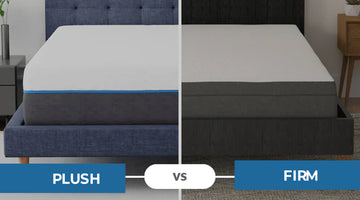Investing in a quality mattress is crucial for your physical and mental well-being. This blog is a comprehensive guide to know about the signs you need to replace your mattress, such as persistent pain, sagging, and increased allergies. It is the first step towards improving your sleep. Consider factors like mattress type, user needs, and material quality when making a purchase. Utilize trial periods and leverage the expertise of mattress suppliers to find the perfect fit. By following a streamlined approach and prioritizing your sleep needs, you can ensure a comfortable and restful night's sleep for years to come.
Sign 1: You're Waking Up in Pain
If you consistently wake up with aches, pains, or stiffness, especially in your back, neck, or shoulders, your mattress may not be providing the proper support for your body.
Sign 2: Your Mattress is Sagging or Lumpy
Over time, mattresses can lose their shape and develop sagging areas or lumps. This can lead to uneven support and discomfort.
Sign 3: You're Experiencing Increased Allergies or Asthma Symptoms
If you notice a worsening of your allergies or asthma symptoms, your mattress could be harboring dust mites, mold, or other allergens.
Sign 4: You're Sleeping Hotter Than Usual
If you find yourself waking up feeling hot and sweaty, your mattress may not be providing adequate temperature regulation.
Sign 5: Your Mattress is Over 7-10 Years Old
Even if you don't notice any obvious problems, mattresses typically lose their effectiveness over time. If your mattress is more than 7-10 years old, it's a good idea to consider replacing it.
You may also like: Mattress Sizes and Dimensions Guide: Find Your Ideal Bed Size
Types of Mattresses and Their Average Life Span
If you're experiencing any of these signs, it's important to address the issue promptly. A good night's sleep is essential for your overall health and well-being.
|
Type of Mattress |
Average Age (Years) |
Reason |
|
Innerspring Mattress |
7-10 years |
Coil systems can sag or break down over time, affecting support and comfort. |
|
7-10 years |
Memory foam can lose its shape and responsiveness, especially with consistent use and heat exposure. |
|
|
Latex Mattress |
10-15 years |
Latex is a durable material that can maintain its shape and support to latex mattress for a longer period. |
|
Hybrid Mattress |
7-10 years |
Hybrids combine coils and foam, so their lifespan depends on the quality of both components. |
|
Airbed Mattress |
5-8 years |
Airbeds can develop leaks or lose air pressure, reducing comfort and support. |
Replacing Your Mattress with Just 2 Calls

Tired of your old, uncomfortable mattress? Replacing it shouldn't be a hassle. You don't need to think about “how to replace a mattress efficiently”. With a streamlined approach, you can upgrade your sleep experience with minimal effort. This guide outlines a simple two-call process to find and receive your new mattress, making the entire experience quick and convenient.
First Call: Best Mattress Supplier
Begin by identifying the best mattress supplier Cloudy Mattress that aligns with your needs and preferences. Visit their website to explore their product range, read customer reviews, and compare prices. Once you've narrowed down your choices, contact their brand experts via phone. Discuss your specific requirements, such as preferred firmness, size, and any underlying sleep issues. Leverage their expertise to guide you towards the ideal mattress for your needs. Once you've made your selection, confirm your order and arrange for convenient delivery.
2nd Call: Home Furniture Removal Service Provider
With your new mattress on its way, it's time to efficiently remove your old one. Start by conducting a quick Google search for "best home furniture removal services" in your area. Contact several service providers to inquire about their services, pricing, and availability. Clearly communicate the size and weight of your mattress, as well as any other furniture items you need removed.
Provide accurate room dimensions to ensure the removal process can be carried out smoothly and efficiently. Schedule a convenient pickup time that aligns with your mattress delivery, ensuring a seamless transition to your new sleep sanctuary.
You may also like: A Guest-Approved Guide to the Best Mattresses For Holiday Visitor
5 Things you Need to Know Before Replacing your Mattress

Before replacing your mattress, consider your current sleep quality. Do you experience frequent back pain, restlessness, or difficulty falling asleep? Track your sleep patterns to identify any recurring issues. Evaluate your current mattress's condition: check for sagging, lumpy areas, or visible signs of wear and tear. Measure your bed's Metal frame and bedroom dimensions to ensure compatibility with your new mattress size. Finally, set a realistic budget for your mattress purchase, considering factors like desired features, brand reputation, and warranty coverage.
1. Type of mattress (Memory foam, Latex, hybrid, innerspring)
Choosing the right mattress type depends on your individual preferences and sleep needs. Memory foam conforms to your body shape, offering excellent pressure relief but can trap heat. Latex mattresses provide good support and bounce, with natural cooling properties. Hybrid mattresses combine innerspring coils with comfort layers like memory foam or latex, offering a balance of support and cushioning. Innerspring mattresses are the most traditional type, providing good support and airflow but may not offer as much pressure relief as other options. Consider your sleeping position, body weight, and temperature sensitivity when selecting a mattress type.
2. User of the mattress (Children, adults, or old)
The ideal mattress type varies significantly depending on the user. Children require supportive mattresses that promote proper spinal development. Look for firm options that resist sagging and provide a stable foundation for growth. Adults need mattresses that offer good support and pressure relief to alleviate common aches and pains. Consider factors like body weight, sleeping position, and any existing health conditions. Older adults may benefit from softer mattresses that provide extra cushioning and pressure relief for joints. Adjustable beds can also be helpful for individuals with mobility limitations.
3. Mattress material (Quality of foam, quality of innerspring, quality of mattress covering sheet)
The quality of materials significantly impacts a mattress's comfort, durability, and overall value. High-quality foam should be dense and supportive while still providing adequate pressure relief. Avoid low-density foams that may sag or break down quickly. Innerspring mattresses should have sturdy coils that provide even support and prevent sagging. Look for individually wrapped coils that minimize motion transfer. The mattress covering sheet should be durable, breathable, and comfortable against the skin. Consider materials like organic cotton, bamboo, or moisture-wicking fabrics.
4. Mattress warranty
Mattress warranties typically cover defects in materials and workmanship, such as sagging, indentations, or broken coils. Common warranty periods range from 10 to 25 year warranty, with varying levels of coverage. Some warranties may be prorated, meaning the manufacturer will only cover a portion of the replacement cost over time. Carefully read the warranty terms and conditions before making a purchase. Understand what is covered, what is not, and any limitations or exclusions. Keep your proof of purchase and warranty information in a safe place for future reference.
5.Trial period for mattress
Many mattress companies offer trial periods, typically ranging from 30 to 60 days, allowing you to test the mattress in your home. This is a valuable opportunity to assess the mattress's comfort, support, and overall suitability for your needs. If you're not satisfied within the trial period, you can usually return the mattress for a full refund or exchange. Take advantage of the trial period to evaluate the mattress thoroughly, considering factors like sleep quality, comfort level, and any potential issues like motion transfer or temperature regulation.
FAQs
1. How much does Mattress Replacement Typically Cost?
Mattress replacement costs vary greatly depending on factors like size (Queen, King), type (innerspring, memory foam, hybrid), and brand. Entry-level mattresses can start as low as $200, while high-end models can exceed $5,000. Consider your budget and desired comfort level when choosing a replacement.
2. Does Mattress Replacement in Winter Cost More than in Summer?
Generally, mattress prices remain relatively stable throughout the year. However, some retailers may offer seasonal sales or promotions during specific periods, such as winter holidays or summer clearance events. It's always a good idea to compare prices from different retailers and look for any ongoing deals.
3. Which type of mattress is easiest to replace?
Mattresses that are lightweight and easily maneuverable are generally easier to replace. This often includes mattresses made with foam materials like memory foam or latex, as they are typically lighter than innerspring mattresses.
4. Can mattress replacement become risky?
While generally straightforward, replacing a mattress can sometimes present certain risks. Improper lifting techniques can lead to back strains or muscle injuries. Additionally, mishandling the mattress during removal or installation can cause damage to the mattress itself or to your home's walls or furniture. Furthermore, the process of removing and replacing your mattress can temporarily disrupt your sleep schedule, potentially leading to sleep disturbances in the short term.
5. What are some reliable sources for mattress replacement?
When searching for a new mattress, consider exploring a variety of sources. Ultimately, the best source for your mattress replacement depends on your preferences and needs.





